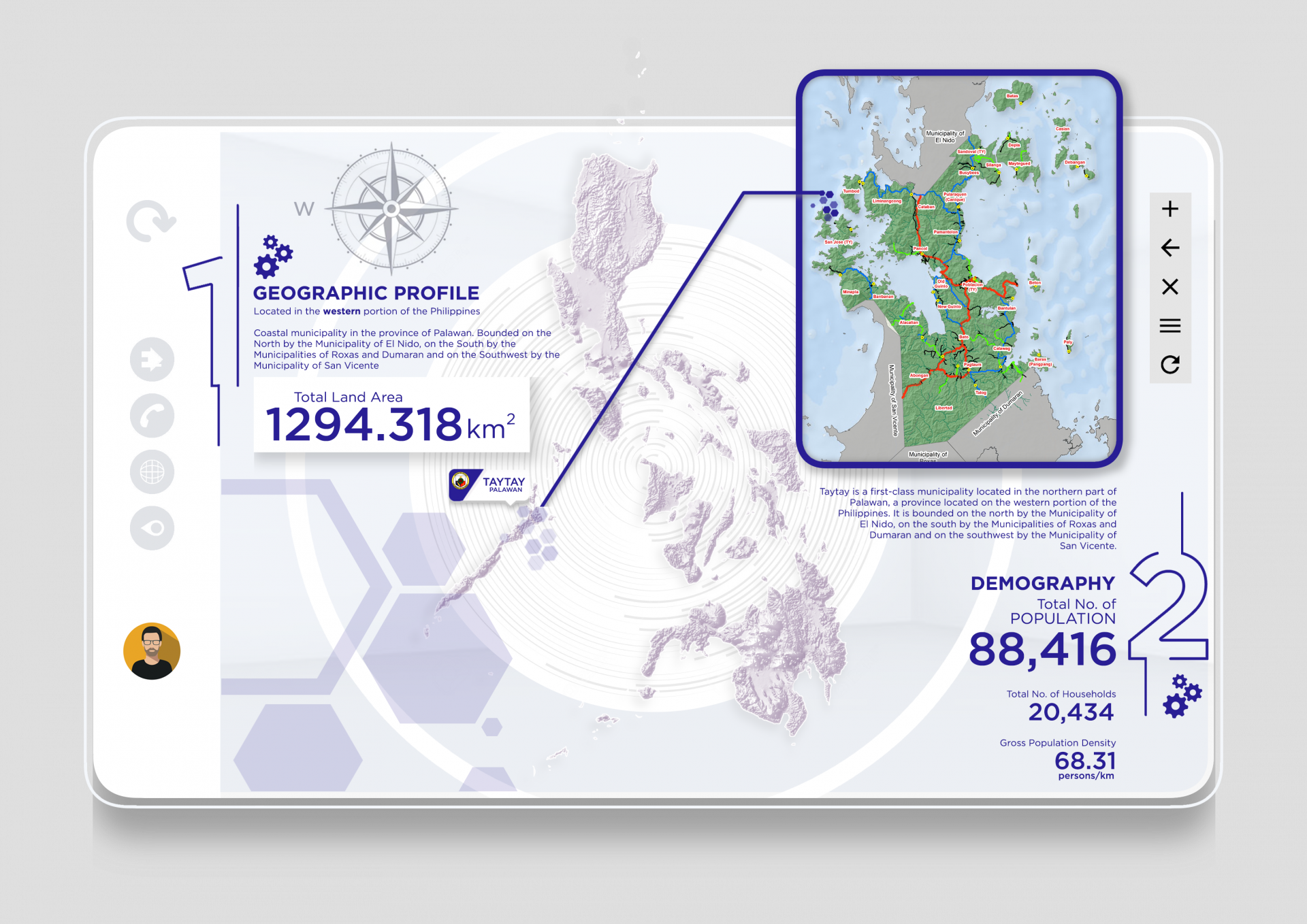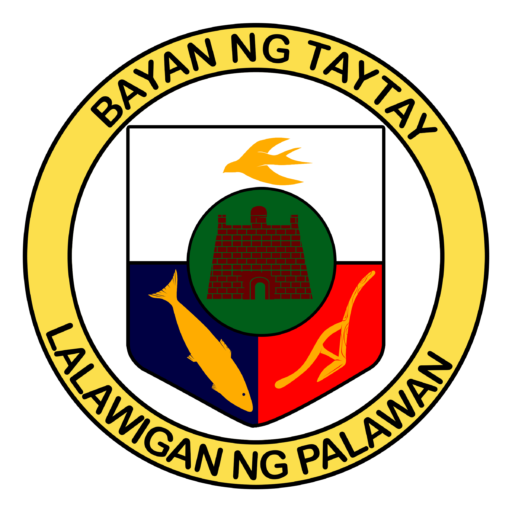










GEOGRAPHICAL LOCATION AND POLITICAL BOUNDARIES
Taytay is a first-class municipality located in the northern part of Palawan, a province located in the western portion of the Philippines. It is bounded on the north by the Municipality of El Nido, on the south by the Municipalities of Roxas and Dumaran, and on the southwest by the Municipality of San Vicente.
Specifically, its relative geographic location is 10° 30′ and 11° 5′ north latitude; and 119° 10′ and 119° 40′ east longitude. In terms of natural boundaries, Taytay is bounded on the east by Taytay Bay and on the west by the West Philippine Sea.
Currently, Taytay has a total land area of 134,238 hectares, which constitutes 9.5% of Palawan’s total area. It is politically subdivided into 31 barangays, of which 9 are island barangays and 22 are mainland barangays. The largest barangay is Abongan (12,158.66 ha or 9.39%) followed by Libertad (10,622.84 ha or 8.21%) and Poblacion (8,589.10 ha or 6.64%). The smallest barangays are usually found in the island such as Debangan (321.47 ha or 0.25%), Paly (371.14 ha or 0.29%) and Biton (755.66 ha or 0.58%).
NATURAL AND PHYSICAL CHARACTERISTICS
The Municipality of Taytay is endowed with different landforms and water bodies within its boundary. Its territory has approximately 120 kilometers in length and 60 kilometers in width. About 65.15 percent of Taytay’s land area (84,336.72 ha) is below 100 meters above sea level (masl) while about 31.92 percent (41,320.14 has) have an elevation of 100 to 300 masl.
LOCAL CLIMATE
The climatic characteristics of the locality are similar to that of the whole province, which is Type I characterized by two distinct seasons, Dry (January – May) and Wet (June – December).
The annual mean temperature in Taytay is 27.36°C. The annual mean temperature can reach up to 31.18°C and as low as 23.54°C. Among the months, the hottest was observed on April (32.11°C) while the coldest is recorded in February (22.64°C).
POPULATION SIZE
As of December 2021, Taytay has a total population of 88,416, with 20,434 total households. Barangay Poblacion has the largest population of 15,128 and the smallest is Barangay Minapla with a population of 860.
REVENUE SOURCES
Taytay, as a first class municipality, has a total revenue of P471,923,094.14 in 2021. Of that amount, P436,858,103.23 is from the Internal Revenue Allotment (IRA) and P35,064,990.91 is from local sources.
Taytay is home to The Malampaya Sound, which has long been touted as the country’s “Fish Bowl”. It’s been said that fish production alone in this part of Palawan corresponds to a large percentage of the overall market for marine products in the country today. With a total water area of 24,490 hectares and a corresponding catchment area of 42,283 hectares for an overall total of 77,773 hectares, the sound is home to a wide array of fish species and other marine products which eventually reach the big markets like Metro Manila and other parts of the country and even as far as the Asian countries of Hong Kong, Taiwan, and Japan.
The Municipality of Taytay is also home to different species of flora and fauna species, some of which are endemic (or can only be found within the area) while others are threatened and or vulnerable.
Taytay is located in the island province of Palawan, the largest in the MIMAROPA region. Aside from being the country’s “last ecological frontier” owing to its vast terrestrial and marine resources, Palawan functions as the region’s main tourism hub, is the highest contributor in fisheries in the region, the top regional and national producer of seaweeds, and the top regional and national producer of cashew. Whilst Taytay is outshone by its neighbors El Nido and San Vicente in tourism, Taytay contributes a sizeable share in the province’s fisheries, seaweed as well as cashew production. It is also one of 10 provincial centers in the region, noted for its provincial and regional role in trade and economic activities linking it to Western Visayas.
The Municipal Agriculture Office (MAO) reported that the main crop products in Taytay include rice, corn, coconut, cassava, cashew, and mango. The “Rice Bowl of Northern Palawan”, it is the top producer of rice in its side of the province, backstopping the supply requirements of nearby towns of El Nido, San Vicente and Dumaran while meeting municipal demand.
In terms of livestock and poultry production, Taytay remains to be dominated by backyard operations, except for four commercial farms based in Poblacion and Paglaum.
In terms of fisheries, Taytay is one of the top producers in the province. Fish catch in Taytay are sourced from five fishing grounds, namely, Malampaya Sound, Taytay Bay, Sharks Fin Bay, Calawag Bay, and Lake Manguao. The two main fishing grounds are (i) the Malampaya Sound, once dubbed as the “fish bowl” of the Philippines for its rich fishing grounds; and (ii) Taytay Bay, best known for its engagement in the Live Reef Fish Trade (LRFT) based primarily on the trading of coral trout locally known as suno.
Taytay is a major producer of seaweeds, producing 611.74 MT in 2017, making it the third-largest producer of seaweeds in Palawan. Pearl farming is also a major industry in Taytay, with its two pearl farm concessions producing about 77.95 MT in the same year.
Based on records from the Business Permitting and Licensing Office (BPLO) of Taytay, the municipality issued 978 business permits in 2018, consisting of applications for commercial/business operations, tricycle, and motor banca permits. As shown in Table 111, the most number of permits issued were engaged in wholesale and retail training – 35.0%, followed closely by transport, storage and communication – 32.7% (including tricycle and motor banca operation permits).
Overall, around 2,064 individuals were employed, of which 68.4% are male and 31.6% female. By industry classification, the majority of the businesses are classified as tertiary sector industries – 85.4%, followed by the secondary sector – 8.7% and the primary sector – 5.9% (mainly engaged in mariculture and commercial animal husbandry). The same database revealed that there were at least 69 businesses engaged in the industrial sector. These include rice mills (27 units), food processing (21 units), ice plants (6 units), and woodworking and sash/furniture shops (6 units). These are notably of small scale and light intensity. In terms of business commercial establishments, there were a total of 914 registered businesses.
As noted, between 2014 and 2018, the number of business establishments grew by 25.8% while total employment increased by 52.4%. A five-year perspective of the number of business establishments by sector indicates that while overall, Taytay business registrations experienced an increase, the largest increase was in the tertiary sector which more than doubled from 346 in 2014 to 835 in 2018. In terms of employment, the tertiary sector also tallied the highest increase in employment, followed by the secondary sector.
All the business establishments registered in 2018 are Micro, Small and Medium Enterprises (MSMEs). About 97.8% are microscale enterprises, e.g. employing less than 10 persons, while the remaining 2.2% are small scale enterprises, e.g. employing less than 100 persons.
Most small-scale enterprises are engaged in food processing, bamboo/rattan plantation and trading, bank/finance, general merchandise construction, resort operations, and pearl farming. Meanwhile, for the micro industries, most are engaged in retail (sari-sari store), and fishing.
Data from the Municipal Tourism Office indicate that Taytay generally receives more tourists in the first half of the year (January to June). Domestic arrivals are more pronounced in the summer months (April and May), while foreign arrivals peak in the months of February and March and gradually decline to off-peak months beginning July up to November, before rising again in December.
It can be noted that most of the identified potential tourist sites are nature-based, owing to their rich marine ecosystems. It also identified some sites for cultural interactions, from which unique community interactions could be developed, maximizing spread effects.

